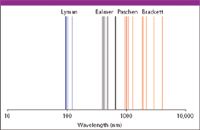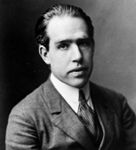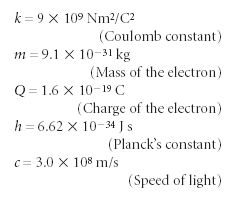The Spectral Lines of Hydrogen
A short history of the early scientific developments related to the optical emission lines of hydrogen is presented. These were crucial to the development of the quantum theory. Balmer's empirical formula was an important milestone. Rydberg and others provided additional work, especially for higher atomic numbers. However, it remained for Bohr to provide the physical reasoning.

Although spectral lines had been observed since the early years of the 19th century, it wasn't until 1860 that Kirchhoff and Bunsen established them as unique to each element. In 1868, Swedish physicist Anders Jonas Ångström (1814–1874) published a detailed study of the wavelengths of solar spectral lines, expressed in units of 10–10 m. This unit is now known as the angstrom (Å).

Volker Thomsen
Johann Balmer
The Swiss mathematician Johann Jakob Balmer (1825–1898) studied at the universities of Karlsruhe and Berlin and earned his doctorate in 1849 from the University of Basel. Beginning in 1859, he taught mathematics at a secondary school in Basel. In 1865 he also became a university lecturer in mathematics at the University of Basel. His main field of interest was geometry. He was persuaded by university colleague E. Hagenbach to search for a mathematical formula to properly characterize the hydrogen spectrum. Previous attempts had failed.
But Balmer succeeded. In 1885 he showed that the wavelengths (λ) of the visible spectral lines of the element hydrogen could be represented by a simple mathematical formula (1):

where n = 2 and m = 3, 4, 5, . . . He called his constant h = 3645.6 Å "the fundamental number of hydrogen." Balmer's empirical formula provided very accurate wavelength values for n = 2 and m = 3, 4, 5, and 6 as shown in Table I.

Table I: Balmer's formula versus measured values
In his paper, he predicted a wavelength for m = 7, and in the same paper notes that he was informed by his colleague at the University of Basel (Hagenbach) that this spectral line had been observed and that the wavelength was in excellent agreement with his prediction. He also showed that his formula accurately produced the wavelengths of several other hydrogen spectral lines.
Balmer also suggested that other spectral line series for hydrogen might be found using other small integer values for n. For those interested, his original (translated) paper is a must read. It is also interesting to note that Balmer was 60 years old when he made this discovery.
Johannes Rydberg
In 1888 the Swedish mathematician and physicist Johannes Rydberg (1854–1919) reformulated Balmer's equation as

where a is a constant, n1 and n2 are integers, and n2 > n1. The constant is now called Rydberg's constant for hydrogen (RH) and has a value of 1.097 × 107 m–1. For the Balmer series of hydrogen lines n1 = 2 and n2 ≥ 3 in this equation.
It is unclear from the historical literature whether Rydberg knew of Balmer's previous work. A recent biography (2) notes that he was independently pursuing research on this problem when he learned of Balmer's work. The authors suggest that this merely helped confirm the direction that he was already pursuing. The Rydberg formula is, however, easily derived from that of Balmer (Appendix 1). Nevertheless, Rydberg's formula pointed the way to other spectral lines series for hydrogen as Balmer had speculated. Rydberg also paved the way for further mathematical clarifications of higher atomic number elements.
Historical Aside
The history of science provides several examples of nearly simultaneous independent discoveries. Perhaps the most famous is the independent discovery of the principle of conservation of energy by a number of scientists and engineers in the mid-19th century. These investigators, along with the date of discovery, are Karl Friedrich Mohr (1837), Julius Robert von Mayer (1841), James Prescott Joule (1843), Ludvig Colding (1840–1843), William Robert Grove (1844), and Hermann von Helmholtz (1847). The periodic arrangement of the chemical elements by Dmitri Mendeleev and Lothar Mayer, a German chemist and physician, is another example. They were jointly awarded the Davy Medal of the Royal Society of Chemistry for their independent work.
More Spectral Lines of Hydrogen
Several other series of spectral lines for hydrogen were discovered in the first half of the 20th century.
In 1906, American physicist Theodore Lyman (1874–1954) discovered the ultraviolet series of spectral lines named after him. For the Lyman series, n1 = 1 and n2 ≥ 2.
In 1908 German physicist Friedrich Paschen (1865–1947) discovered the infrared series of spectral lines for which n1 = 3 and n2 ≥ 4. An expert in electrical discharges, he taught at several German universities.
In 1922, American physicist Frederick Brackett (1896–1980) discovered the infrared series that bears his name. In the Brackett series, we have n1 = 4 and n2 ≥ 5.
In 1924, American physicist August Herman Pfund (1879–1949) discovered a series of spectral lines of hydrogen that is also in the infrared. For the Pfund series, n1 = 5 and n2 ≥ 6.
In 1953 American physicist Curtis Humphreys (1898–1986) discovered the hydrogen spectral line series in which n1 = 6 and n2 ≥ 7.
The first four series of spectral lines for hydrogen (n1 = 1, 2, 3, 4) are shown in Figure 1. Note the logarithmic scale for wavelength.

Figure 1: Some wavelengths for four series of hydrogen spectral lines.
Rydberg and others were searching for the physical reasons for the formula. It remained a mystery until the theoretical work of Niels Bohr.
Niels Bohr and Early Quantum Theory
In 1913 the Danish physicist Niels Bohr (1885–1962) proposed a modification of the Rutherford model of the atom with which he was able to derive Rydberg's formula (3). He suggested that the electrons could only "orbit" at fixed radii from the nucleus. Making use of Max Planck's quantum concept (E = hν), he postulated that the electron angular momentum must be some integer multiple of Planck's constant. Bohr's derivation of Rydberg's formula is presented in Appendix 2. For his groundbreaking work, which led to the development of modern quantum theory, he was awarded the Nobel Prize in physics in 1922.

Niels Henrik David Bohr.
Figure 2 provides a somewhat simplified electron energy level diagram for the hydrogen atom, with the ground state of the electron (n = 1) along the bottom along with several "excited states" corresponding to n = 2, 3, 4, 5, and 6, indicated in bold horizontal lines. The y axis shows the energy in electron volts (eV) required for the ground state electron to make the transition to these excited states. The dashed line at the top of the diagram corresponds to 13.6 eV, the ionization energy of the electron. The electron transitions that result in the various hydrogen spectral line series discussed above are also indicated.

Figure 2 : Electron energy level diagram for hydrogen.
Concluding Remarks
The late 19th century empirical formulas by Balmer and Rydberg on the spectral lines of hydrogen provided crucial confirmation of the strength of Bohr's early quantum theory.
Appendix 1: Equivalence of Balmer and Rydberg Formulas
Start with Balmer's formula, equation 1 in the text above. Take the reciprocal of both sides to arrive at

Let R = n2/h, where n = 2 and we find R = 1.0792 × 107 m–1, Rydberg's constant.
Appendix 2: Bohr Model Derivation of Rydberg's Formula
A classical calculation of the velocity of the electron in the hydrogen atom assumes that the centripetal force (mv2/r) holding the electron in its orbit is provided by the electrical force (kQ2/r2) between the nucleus and the electron. That is, mv2/r = kQ2/r2 or

To make his model of the atom agree with the known atomic spectra, Bohr had to assume that the orbiting electrons could have only certain radii, certain energies, and certain values of angular momentum. Specifically, he postulated that the only allowed orbits were those for which the angular momentum (L = mvr) was some integral multiple of h/2π, where h is Planck's constant. That is

We want to combine Bohr's angular momentum "quantization" condition (equation 2) with the centripetal force result (equation 1) and arrive at the total energy of the system. This total energy is the sum of the kinetic energy (KE) and potential energy (PE) of the electron, E = KE + PE.
The kinetic energy is given by KE = ½mv2. The potential energy is the product of the electrical force between the proton in the nucleus and the negatively charged electron and their separation. This is expressed as PE = Fes.
Therefore, we need to calculate both the velocity and the radius of the electron. This can be achieved as follows:
Solve for the velocity in equation 2, square it, and substitute into equation 1. This gives us the radius:

Substitution back into equation 1 gives the velocity

Now we can calculate the total energy of the system. Starting with the kinetic energy term, we have

Now for the potential energy we have

Therefore, total energy is

With the exception of n, the number of the energy level, everything else in the above equation is a constant.
We can use a combination of Planck's law (E = hν) together with Bohr's energy levels to derive Rydberg's formula for the wavelength of the light emitted by a hydrogen atom. For an electron energy level transition, Planck's law can be written in the form

where Ei and Ef represent the initial and final electron energy levels, respectively. Then,

or

We now identify the constant term above with the Rydberg constant for hydrogen (RH = 2π2mk2Q4/h3c).
The values of the constants are:

Making the substitutions, we find RH = 1.097 × 107 m–1, the value quoted in the text above.
Volker Thomsen, a physicist by training, has some 30 years of experience in elemental spectrochemical analysis (OES and XRF). He is currently a consultant in this area from his home in Atibaia, São Paulo, Brazil. His other interests include mineralogy and history of science. Occasionally, he still plays the blues harmonica. He can be reached at vbet1951@uol.com.br.
References
(1) J.J. Balmer, Annalen der Physik und Chemie 25, 80–85 (1885). Available online.
(2) I. Martinson and L.J. Curtis, Nucl. Instrum. Methods Phys. Res., Sect. B 235 17–22 (2005). Available online.
(3) N. Bohr, Philosophical Magazine, Series 6, Vol. 26, 1 – 25 (July 1913). Available online.

Newsletter
Get essential updates on the latest spectroscopy technologies, regulatory standards, and best practices—subscribe today to Spectroscopy.
New Study Expands Nickel Autoionization Spectra to Advance Laser Isotope Separation Technologies
July 17th 2025Researchers at China’s National Key Laboratory have identified 170 nickel autoionization states using resonance ionization mass spectrometry, significantly advancing the spectral database critical for laser isotope separation and atomic spectroscopy.
AI-Powered Fusion Model Improves Detection of Microplastics in the Atmosphere
July 17th 2025Researchers from Nanjing University of Information Science & Technology have introduced a breakthrough AI-enhanced multimodal strategy for real-time detection of polyamide microplastics contaminated with heavy metals.